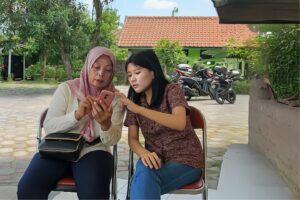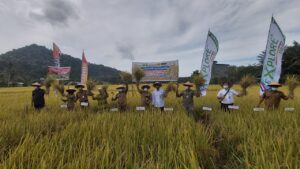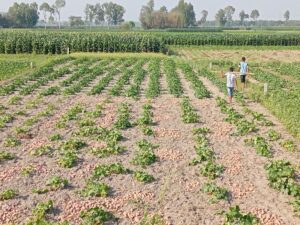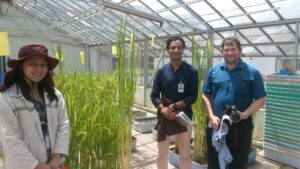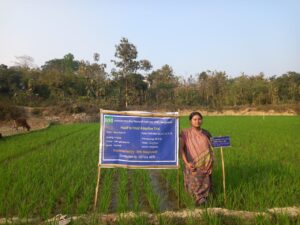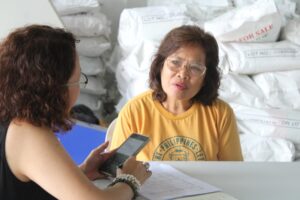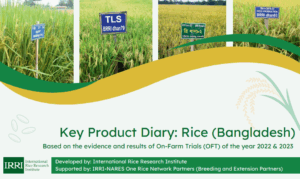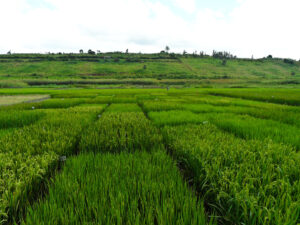
Rice thrives in a flooded ecosystem. These conditions enrich the nutrients available for the crop’s growth, allowing farmers to reap abundant harvests. The downside, however, is that this flooded ecosystem emits large amounts of methane—a major greenhouse gas (GHG)—that contribute to global climate change.
One of the effects of climate change is drought, which now occurs more frequently in some regions. This aggravates water shortages, which thus threaten rice production even more. Hence, water-saving techniques have been developed, particularly by the International Rice Research Institute (IRRI), such as alternate wetting and drying (AWD) and the growing of aerobic rice in well-drained, nonpuddled, and nonsaturated soils (see The big squeeze and, High and dry ).
 In this bid to conserve water, however, the environmental impacts of these methods have yet to be established. Needless to say, the two water-saving techniques have advantages and disadvantages. AWD, for one, maintains the basic features of flooded rice fields and keeps the potential for high production intact.
In this bid to conserve water, however, the environmental impacts of these methods have yet to be established. Needless to say, the two water-saving techniques have advantages and disadvantages. AWD, for one, maintains the basic features of flooded rice fields and keeps the potential for high production intact.
However, although this practice reduces methane emissions, it can potentially increase the release of nitrous oxide—another GHG. Aerobic rice systems similarly entail drastic changes in carbon and nitrogen emissions and canopy temperature that contribute to global warming and aggravate heat stress for the rice plants, respectively.
Although the consequences for the sustainability of rice fields remain unknown, it is worthwhile to thoroughly assess the use of aerobic rice, and AWD, as an option to mitigate the dire effects of climate change and, at the same time, reduce emissions.
Hence, in response to these concerns, IRRI conducted two distinct field measurements to determine just how much AWD and aerobic rice growing contribute to climate change (see Goodbye gas).
One goes down, another goes up
Methane emissions from rice fields are mainly determined by the application of water and organic inputs. Again, the more flooded the field is, the more methane is released. The emission of this particular GHG is also influenced by the type of soil, weather, tillage management, residue, fertilizer, and rice cultivar. Recent assessments of irrigated rice cultivation estimate that, in 2000, its global emissions were equivalent to 625 million metric tons of carbon dioxide.
Since flooding the soil sustains methane emissions, shifting to a more conservative way of applying water in rice fields appears to be the best solution to reduce the amount of methane released into the atmosphere. To note, AWD effectively lessens the water used in irrigation by 15–30%.
The first experiment IRRI did in 2006 covered eight crop seasons and measured GHG emissions captured in chambers installed in AWD fields. This study confirmed that water-saving techniques are indeed effective in mitigating the net global warming potential (GWP) of rice fields.
These methods, however, raise the risk of increasing nitrous oxide emissions when a high amount of nitrogen fertilizer is applied. This can offset or even supersede any GWP savings made by lowered methane emissions.
These findings can be used to explain conflicting reports on the net GWP water-saving techniques had in earlier studies conducted in different regions and under different N management practices. There seems to be a growing consensus that water-saving techniques can still keep nitrous oxide emissions relatively low if nitrogen is applied in appropriate doses.Thus, the aim should be to combine techniques of (1) water saving and (2) efficient N-use management as a means to reduce GHG emissions.
The warmer field
IRRI conducted its second study in 2008 during the wet and dry seasons to compare the seasonal changes in heat, water vapor, and carbon dioxide in a lowland (flooded) and aerobic rice environment using the eddy covariance (EC) method (see Figure).
EC is the standard micrometeorological method that directly measures CO2 and heat exchange over a larger area. Unlike the chambers used in the study described above that cover an area of only 1 square meter per chamber, the EC’s minimum scope is a 100-meter radius corresponding to a field size of 4 hectares when the system is located in the center. The EC system at IRRI is actually the first in the Philippines.
Powered by a solar panel, the system consists of a sonic anemometer that senses wind coming from all directions to record its gas composition, an open path CO2/H2O infrared analyzer, as well as sensors for radiation, temperature, and humidity. All these sensors can generate 10 data records per second. These data are then stored in a data logger.

Based on the 2008 findings, lowland rice fields sequester more carbon from the atmosphere than aerobic rice fields. This is attributed to lowland rice’s higher photosynthetic capacity to convert carbon into organic compounds and to the slow organic matter decomposition in flooded soils. In turn, the conversion from a flooded to an aerobic system entails net emissions from soil organic carbon that have to be taken into account to compute the net GWP (see above) of these systems.
Moreover, IRRI found out that the temperature and water vapor profiles in rice canopies of these two different environments vary significantly. The difference was particularly observed in the records of what is scientifically called “sensible heat flux” and “latent heat flux.” Sensible heat is the energy that warms the surrounding air, whereas latent heat is the energy stored as water vapor. IRRI learned that, on an annual basis, aerobic rice fields had 58% more sensible heat flux and flooded fields had 18% more latent heat flux. This distinction has implications for the heat stress the rice plant is exposed to in either system. Heat stress caused by high temperatures is aggravated by high humidity. The distinct microclimates in the canopy result in more temperature-related stress in non-flooded rice fields and more vapor-related stress in flooded fields.
Facing climate change
As much as growing rice and saving water are important, their effects on climate change mean more challenges ahead. This demonstrates how complex the world can be, as we try to plug one hole and another one bursts open that equally needs attention. Nevertheless, this only goes to show how the world needs to find a balance. Aside from saving water, it is also important to consider the overall effect of these water saving technologies on climate change, while at the same time ensuring food security.
The International Rice Research Institute’s (IRRI) work has demonstrated the potential to reduce greenhouse gas (GHG) emissions in rice production with relatively low opportunity costs and, in some cases, with increased productivity. Adapting technologies to local conditions is necessary, and this involves local farmers, extension agents, and research institutions in technology design and dissemination.
Technically, methane reduction from irrigated rice could be a promising strategy to mitigate GHG emissions in line with the idea of Certified Emission Reductions (CERs) introduced in the Kyoto Protocol. According to this regulation, farmers can receive payments from a private or public institution in an industrialized country for reducing GHG emissions.
In the next step, a designated panel of the United Nations Framework Convention on Climate Change can approve CERs that can be used by the purchasing institution as part of its required contingent of emission savings.
 Now, however, there is no CER project in rice production. One obstacle is the reluctance of the UNFCCC panel to accept projects in the land-use sector. Even if this changes in the near future, the existing regulations for CERs obstruct funding of GHG mitigation through water-saving projects. Water-saving techniques can reduce GHG emissions in a given area of rice land, but, in most cases, the saved water will then be used to irrigate more rice land or new crops in future seasons.
Now, however, there is no CER project in rice production. One obstacle is the reluctance of the UNFCCC panel to accept projects in the land-use sector. Even if this changes in the near future, the existing regulations for CERs obstruct funding of GHG mitigation through water-saving projects. Water-saving techniques can reduce GHG emissions in a given area of rice land, but, in most cases, the saved water will then be used to irrigate more rice land or new crops in future seasons.
Subsequently, reduced emissions caused by these techniques are offset by emissions created in newly irrigated land. Ironically, if the saved water were channeled to other users, for example, in residential areas, one could rightfully claim CERs because of a net reduction in global warming potential (GWP) caused by the mitigation project.
Increasing food production is an absolute necessity for the human population, and improved resource use efficiencies are imperative to achieving this goal. As an agricultural research institution devoted to increasing food production, IRRI proposes specific provisions for CER allocations in the land-use sector to converge the legitimate goals of food security and GHG mitigation in a Copenhagen agreement. Our suggestion is to compute net GWP savings based on food production targets. As long as saved resources, namely, water and fertilizer, are used to increase food production in a resource-efficient manner, it seems unreasonable to account for new emissions as offsets in or leakages from a mitigation project.

